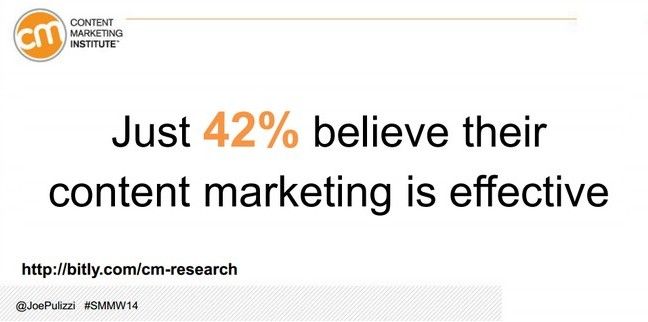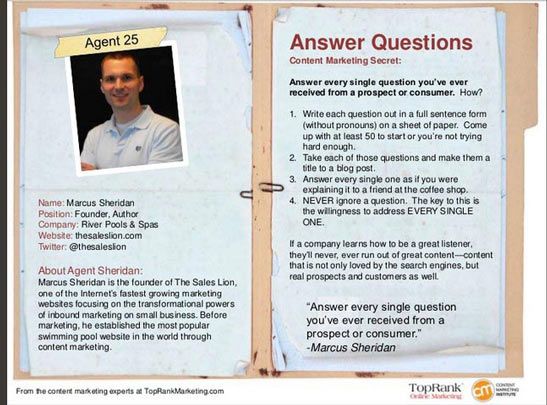In March, the whole Agorapulse team traveled to San Diego on a mission to attend the best sessions at Social Media Marketing World, compile notes of the key takeaways and share them with you. We’ve created 20 blog posts from those notes, here’s one of them!
Session Title: 5 content marketing practices businesses ignore (and you should not)
Speaker: Joe Pulizzi, Founder & CEO of the Content Marketing Institute and the great event, Content Marketing World. If you are looking to improve your skills in content marketing, don’t miss this event in Cleveland this September. Guess what? Kevin Spacey will be the closing keynote!
Why you should read this session’s transcript: Joe is known as the father of content marketing and has founded the Content Marketing Institute as well as Content Marketing World, the biggest event in the content marketing industry. If you are looking for great advice on how to improve your content marketing strategy and rock at social media, this is the session to read!
Quote from the session: “The cardinal rules of content marketing are that nobody cares about us, nobody cares about our corporate stuff, nobody cares about our products and services. Successful content marketing is about stuff people care about!”
The problem: According to a study conducted by the Content Marketing Institute, only 42% of marketers believe that content marketing is effective. That’s not enough! Joe wants you to be in that 42%, and here is his advice for that.
The reason why most people fail: Lack of consistency. If a content marketing strategy is about creating valuable, compelling and consistent content, the number 1 reason most content marketing plans fail is because they’re not consistent. Long term commitment is the most essential key to a successful plan.
According to IBM, 85% of corporate blogs have 5 or fewer posts. That means that only 15% of them have a consistent content creation plan. That’s a great opportunity for those 15%! If you are among the consistent content marketers, you’re only competing with 15% of your competitors as 85% are probably not doing a good job. That’s great news for you!
#1 Make sure your content marketing is generating Sales, Savings or Sunshine
Don’t just jump on the content marketing wagon (blog, podcast, social, etc.) if you haven’t figured out why you want to do it and what results you’re expecting.
There are 3 types of goals you should pursue:
- Creating happier customers (Sunshine)
- Generating revenues (Sales)
- Saving money (Savings)
You don’t want to create content for the sake of creating content (no matter how good it is). You want to create content that is geared toward achieving one of these 3 goals. No exceptions.
#2 Create a content marketing mission statement
The mission statement is the reason you’re investing in content marketing. It should define who you’re targeting with that content, what channels you’ll use to reach them, what impact you want to have on the audience and what actions / results you want to obtain.
When it comes to defining your target audience, target as narrowly as possible. Trying to be everything to everyone won’t work.
When it comes to choosing channels for your content marketing distribution (blog, Facebook, Twitter, Slideshare, Pinterest, etc.) ask yourself “why” you want to be present on that channel. As long as you don’t have a good answer to that question, don’t start. This should be your starting point.
Concerning the impact you want to have on the target audience, you are not limited to one. You can offer them better product support, help them grow their skills, help them have more quality time with their relatives, etc. At the end of the day, it’s all about how you want your brand and its content to be remembered by your target audience and, as a consequence, how you want to impact their lives.
Last, but not least, you need to be very clear about the end result you’re going after. Whether it’s more leads, less support tickets, improving your Net Promoter Score, increasing your customers’ lifetime value, you need to be clear about the goal(s) your content should help you achieve and be in a position to measure your progress over time.
#3 Never build your content ship on rented land
The example of Facebook is a great illustration: Brands invested a lot to recruit fans when organic reach was compelling, but now that it’s decreasing for most brands, that investment has less value. Building your presence on rented land such as Facebook is a risky thing to do.
Personal note: I tend to disagree with the statement that Facebook is not letting brands reach their customers organically (read my post on the subject), but I do agree that Facebook shouldn’t be your home base.
In a nutshell: you need to own your content home base.
#4 Invest for the long term (3 years?)
Very (I mean VERY) important point raised by Joe: Content marketing takes time to prove valuable.
So, how long should you wait for your content strategy to pay off in a measurable way?
A three year plan is pretty common in Joe’s experience.
If you only have 6 months to prove measurable results, just advertise, you won’t have enough time for a content marketing plan to pay off.
According to Joe, a content marketing plan pays off after 3 years on average. Don’t invest in content today if you need to see significant results in 3 months. You won’t have enough time to demonstrate a positive ROI.
#5 Leverage Influencers then build an audience
First, you have to find influencers who can help spread your content to your target audience.
Joe had a list of 42 influencers when he started the Content Marketing Institute. We have our own list at Agorapulse with almost 30 of them 🙂
Then, use the 4:1:1 rule. Out of 6 tweets (or Facebook posts, etc.):
-
- o
- Post 1 piece of promotional content
o
-
- Post 1 piece of your own content
o
- Post 4 pieces of influencer’s content (and tag or mention them in it).
Do this for months with your influencers’ list, and then, when you start diving into your content creation strategy, include them in it. Then, they will share your content on their own channels and boost your content distribution!
This is why the Content Marketing Institute has been creating ebooks about the biggest influencers in its industry and their thoughts on specific topics (visual content, social media content, etc.).
For a good example of how the Content Marketing Institute leveraged this strategy in a very smart manner, check the 29 Content Marketing Secrets e-book.
Personal note: this is a great strategy Joe, I love it!
One of the 29 experts’ secrets are shared in this ebook:
#6 Buy vs. build
Sometimes, buying a media company is a better (and faster!) way to achieve your content marketing goals!
For example, Adorama, a camera store, bought JPG, a magazine about photography with 400,000 subscribers. Pretty good move.
Is there a media or a blog with a good audience that would be a good fit for your brand? Sometimes, it’s faster, cheaper and less risky to acquire an existing media instead of building your own. And it may not be as expensive an option, some media are struggling to monetize their audience and could be ready to sell for an affordable purchase price.
Key Takeaways:
- Set your goals (Sales, Savings, Sunshine)
- Know why are you using each channel?
- Focus on the reader’s outcome (the value you want to offer them)
- Have a mission statement (why you’re doing it, what your content should be about)
- Don’t build on rented land, own it
- Growing your subscribers’ list is the best goal
- Build an influencers’ list first to help you build an audience later
- Leverage your relationship with these influencers to include them in your content
Let’s have a look at successful business cases
How John Deer does it: They created a magazine around the topics their clients, farmers, cared about. This magazine (The Furrow) is now the leading media in the farming industry with 1.5M subscribers in 40 countries!
How Procter & Gamble does it: They’ve launched a website called “Home made simple” delivering recipes, organizational tips for the home, etc., and since the launch in 2003, they’ve had way over 10M people signing up for their newsletter. Their mission statement was “enabling women to have more quality time with their families”
How Ameritrade does it: Ameritrade is an online trading company and launched “Think Money”, a magazine about investment, stuffed with advance analysis and advice about how to best invest your money. After several years, their data taught them that subscribers to ‘Think Money’ trade 5 times more than non-subscribers. That content strategy proved to be their best marketing investment.
If you liked Joe’s takeaways as much as we did, you should definitely read his book: Epic Content Marketing!







